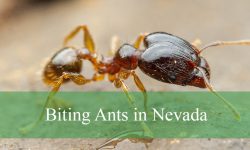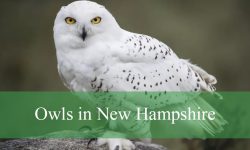Small but full of energy, wrens are among the most charming birds you can find across Pennsylvania. Known for their loud songs and restless movements, these tiny birds bring life to forests, gardens, and wetlands throughout the state.
Pennsylvania hosts a mix of year-round residents, summer breeders, and occasional visitors. From the bold Carolina Wren that sings even in winter to the elusive Winter Wren hiding in mossy logs, each species has its own unique traits that make it fascinating to observe.
In this guide, we’ll explore the seven wrens recorded in Pennsylvania, with details on their identification, behaviors, and the best places to spot them. Whether common or rare, every wren adds to the state’s bird diversity and offers birdwatchers exciting opportunities.
Types of Wrens Found in Pennsylvania
Carolina Wren
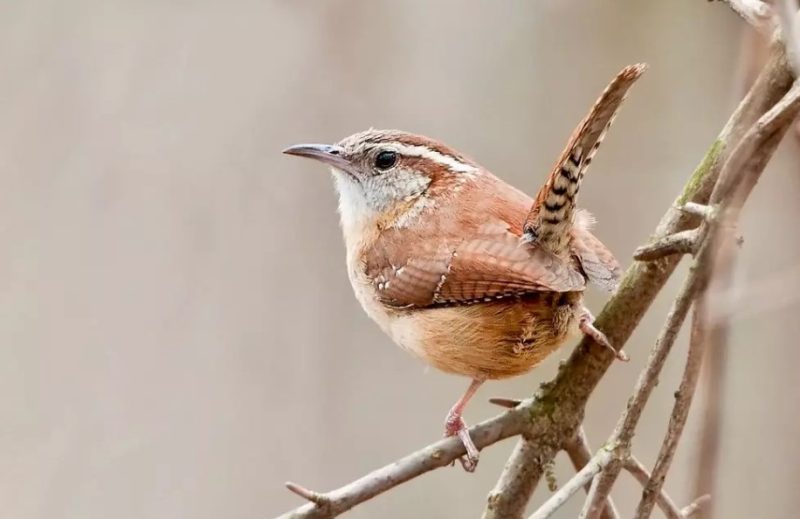
The Carolina Wren is one of the most recognizable wrens in Pennsylvania and is a year-round resident. It is medium-sized for a wren, measuring about 5 to 6 inches in length, with a wingspan of roughly 11 inches. Its plumage is a warm reddish-brown on the back with buff-colored underparts, and it is easily identified by the bold white eyebrow stripe that contrasts against its dark face. The slightly curved bill is adapted for probing insects, while its tail is often held upright in a characteristic wren posture.
This bird is famous for its loud, ringing song often described as “tea-kettle, tea-kettle, tea-kettle,” which can carry across neighborhoods and woodlands. Males sing year-round, even in the middle of winter, making them one of the more vocal wrens. Their call notes are sharp and metallic, used for both communication and territorial defense.
Carolina Wrens are insectivores for much of the year, feeding on beetles, caterpillars, spiders, and other small invertebrates, but they will also eat seeds, berries, and suet from backyard feeders, especially in colder months. They forage actively in brush piles, leaf litter, and low vegetation, often flicking their wings and tails as they move.
They are adaptable and thrive in wooded suburbs, shrubby thickets, and rural farmlands, often nesting close to human habitation. Their nests are bulky, dome-shaped structures of twigs, moss, and leaves, tucked into tree hollows, birdhouses, or even unusual spots like mailboxes and hanging baskets. Their ability to live near people makes them one of the most commonly seen wrens in Pennsylvania.
House Wren
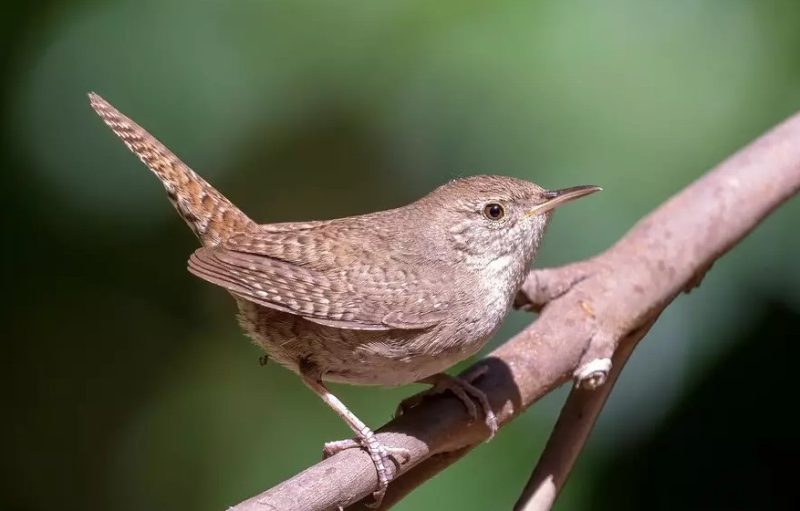
The House Wren is a small, plain brown bird that is a common summer visitor in Pennsylvania, typically arriving in April and leaving by late September. Measuring about 4.5 to 5 inches in length with a wingspan of 6 to 7 inches, it is smaller than the Carolina Wren. Its plumage is overall brown with subtle barring on the wings and tail, lacking strong markings except for faint eye lines. Despite its unremarkable appearance, its energetic behavior and cheerful song make it a delight to observe.
House Wrens are prolific singers, with males producing bubbling, chattering songs during the breeding season to attract mates and defend territories. Their calls are sharp and scolding, especially when potential predators approach their nests. They are highly aggressive toward other cavity-nesting birds, often evicting competitors and even puncturing their eggs.
Their diet consists mainly of insects such as beetles, caterpillars, flies, and grasshoppers, which they catch by probing bark crevices, shrubs, and garden plants. They are highly active foragers, constantly flicking their tails and wings while searching for food. During migration, they may also consume berries to supplement their diet.
House Wrens prefer open woodlands, gardens, and suburban backyards, where they readily use nest boxes or cavities in trees, fence posts, and even man-made structures. They build loose nests of sticks, grass, and feathers, and are known for filling multiple cavities in their territory, giving them a competitive edge over other birds. Their adaptability has allowed them to become one of the most widespread wrens in North America.
Winter Wren

The Winter Wren is one of the smallest wrens in Pennsylvania, measuring only 3 to 4 inches long with a wingspan of 5 to 6 inches. Its compact body, very short tail (often cocked upward), and fine barring across its brown plumage make it distinctive. The bird’s dark, heavily patterned appearance blends seamlessly with the undergrowth, making it difficult to spot despite its energetic movements. A pale eyebrow stripe and fine bill help with identification in the field.
Although tiny, the Winter Wren is renowned for its extraordinarily long and complex song, a cascade of trills and whistles that can last up to 10 seconds. Males sing vigorously in spring and summer, especially in dense, moist forests where their voices echo. Their calls are thin and high-pitched, often heard before the bird is seen.
Winter Wrens are ground foragers, hopping actively through leaf litter, mossy logs, and tangled brush in search of insects, spiders, and larvae. Their small size allows them to slip into tight crevices while hunting. During colder months, they may roost communally for warmth, sometimes squeezing several birds into a single cavity.
They favor dense forests, especially coniferous or mixed woodlands with plenty of downed logs, brush piles, and damp understory vegetation. In Pennsylvania, they are more often observed during migration and winter, as their breeding range is farther north. Their preference for shaded, mossy habitats sets them apart from other wrens in the state.
Marsh Wren
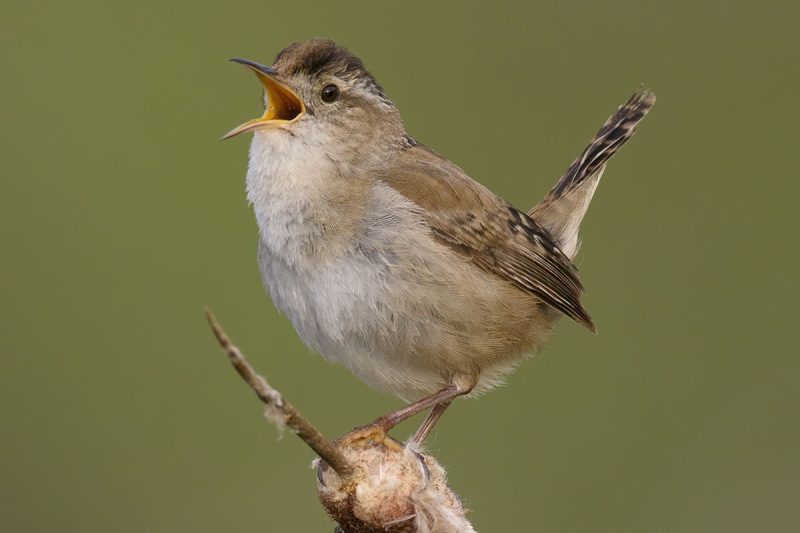
The Marsh Wren is a wetland specialist, found in cattail marshes and wet meadows across parts of Pennsylvania during the breeding season. Measuring about 4.5 to 5.5 inches long with a wingspan of 6 to 7 inches, it has a bold appearance with a pale eyebrow stripe, brown upperparts streaked with black and white, and a short, often upright tail. Its sharp bill is well-suited for picking insects off reeds and grasses.
Males are known for their loud, buzzy songs that resemble a series of mechanical rattles and trills. They often sing persistently from exposed reed stalks, announcing their territories. Their calls are sharp and scolding, helping to defend their nests from intruders.
These wrens feed primarily on insects and spiders, which they find by climbing among cattails and sedges, often dangling acrobatically as they forage. Their behavior is secretive, but males become more conspicuous during the breeding season when singing from prominent perches.
Marsh Wrens are prolific nest builders, often constructing multiple dome-shaped nests woven from cattail leaves and grasses. Only one nest may be used for raising young, while the others function as decoys to deter predators or competitors. Their strong association with wetlands makes them an important indicator species for the health of marsh ecosystems in Pennsylvania.
Sedge Wren
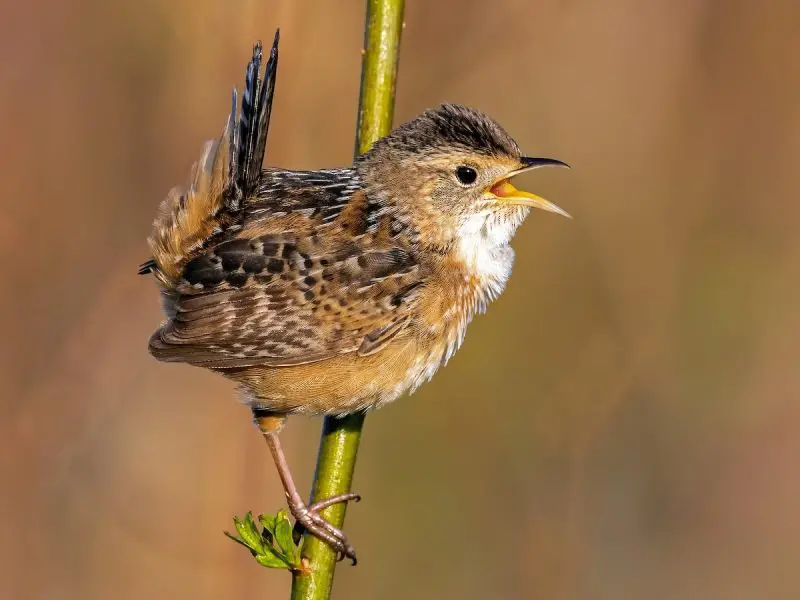
The Sedge Wren is a small and elusive bird that is considered uncommon in Pennsylvania, typically found in wet meadows and grassy marshlands. Measuring only about 4 to 4.5 inches long with a wingspan of around 6 inches, it is one of the smallest wrens in the state. Its plumage is brown with fine streaks on the crown and back, giving it a more patterned appearance than the Marsh Wren. A pale eyebrow line and short tail, often held upright, are also key identification features.
This species has a high-pitched, rapid song that sounds like a dry, insect-like chatter, quite different from the melodic songs of other wrens. Males often sing persistently from tall grasses or sedges, making them easier to detect during the breeding season. Their call notes are thin and sharp, used to maintain communication within dense vegetation.
Sedge Wrens feed primarily on insects such as grasshoppers, beetles, caterpillars, and small spiders, which they glean from sedges, grasses, and low plants. They forage quietly, moving quickly through vegetation, often remaining hidden from view. Their diet is almost entirely insectivorous, helping to control insect populations in their habitats.
Nesting takes place in thick grasses where the male builds multiple spherical nests out of woven sedge and grass stems. Only one nest may be used for raising young, while the others are abandoned or serve as decoys. Because they require undisturbed grassland habitats, Sedge Wrens are vulnerable to habitat loss, making them a rare but special sight in Pennsylvania.
Rock Wren
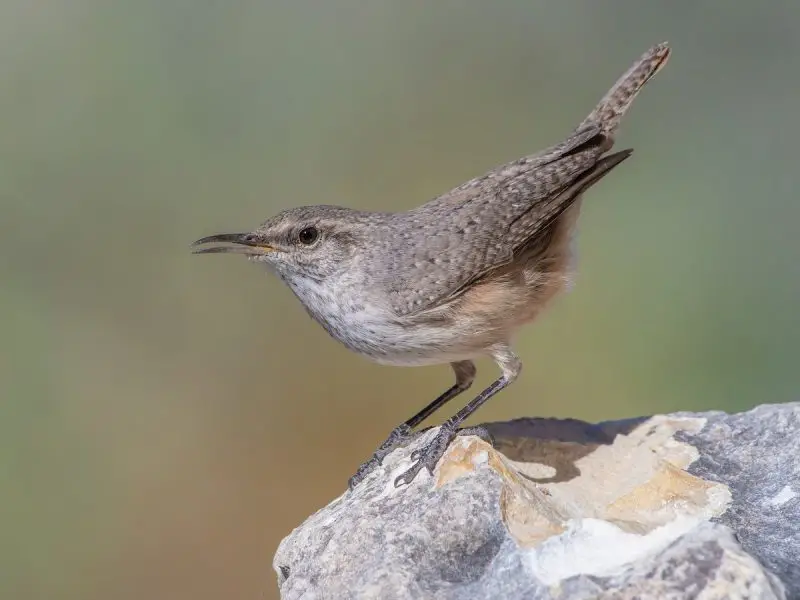
The Rock Wren is a rare visitor to Pennsylvania, usually seen only occasionally during migration. It is larger than some other wrens, measuring about 5.5 to 6.5 inches long with a wingspan of up to 9 inches. Its plumage is gray-brown above with fine streaks, pale underparts, and faint barring on the wings and tail. The long, slightly curved bill and slender body shape are good field marks.
Unlike most wrens in Pennsylvania, the Rock Wren favors rocky habitats such as outcrops, cliffs, and stony embankments. Although such terrain is not widespread in the state, sightings occur when individuals stray from their normal western range. When perched on rocks, they often bob up and down, a behavior typical of the species.
Their song is a varied series of whistles, trills, and short notes, often delivered from prominent rocky perches. They also give sharp calls to warn of intruders. Males sing extensively during the breeding season, which in their core range takes place in arid, rocky landscapes.
The Rock Wren feeds on insects and spiders, often probing into rock crevices to find prey. They use their long bill to extract beetles, ants, and other small invertebrates from cracks in stone surfaces. Although rare in Pennsylvania, their distinctive habitat preferences and unique behavior make them one of the more unusual wrens occasionally recorded in the state.
Bewick’s Wren
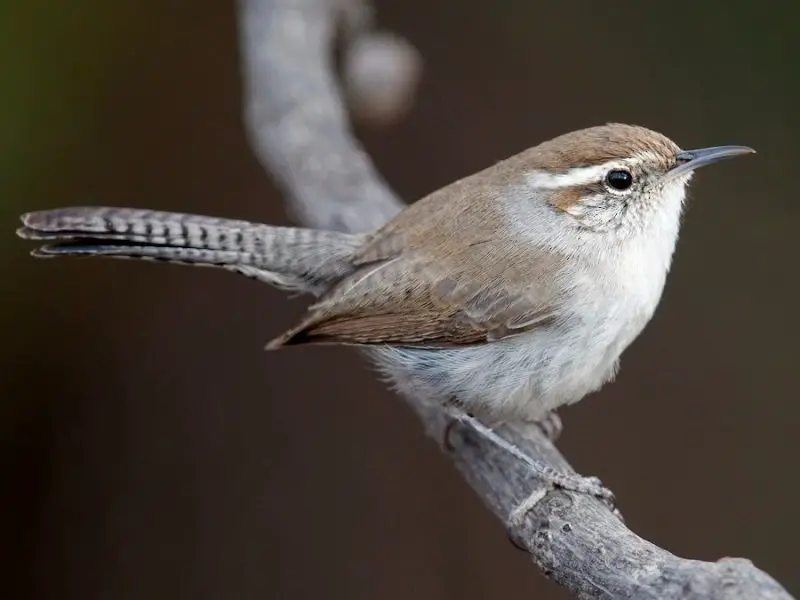
The Bewick’s Wren is another rare species in Pennsylvania, with historical records showing it was once more widespread in the eastern United States before declining significantly. It is medium-sized for a wren, measuring about 5 to 5.5 inches long with a wingspan of 7 inches. Its most distinctive feature is the long white eyebrow stripe, which is more pronounced than that of the Carolina Wren. The plumage is gray-brown above with a pale underside and a long tail often tipped with white edges.
Its song is rich and musical, with a series of whistles and trills that vary widely among individuals. Males have large repertoires and can sing dozens of different song variations. Their call notes are sharp and nasal, used for both communication and territory defense.
Bewick’s Wrens forage actively in shrubs, brushy areas, and thickets, flicking their tails and probing leaves for insects and spiders. Their diet is primarily insectivorous, but they will also consume seeds and berries in colder months. Their active behavior and tail movements make them easy to spot when present.
This species prefers brushy habitats, forest edges, and scrublands, often nesting in cavities, crevices, and birdhouses. In Pennsylvania, they are now considered very rare, with only occasional records. Conservation concerns such as habitat loss and competition with House Wrens have contributed to their decline in the East, though they remain common in western parts of the United States.
Best Times and Places to Observe Wrens in Pennsylvania
Wrens can be observed year-round in Pennsylvania, but the best viewing opportunities depend on the species. The Carolina Wren is a permanent resident, making it possible to spot them in all seasons, even during winter when their loud “tea-kettle” song often echoes through quiet woodlands and neighborhoods. House Wrens, by contrast, arrive in spring and stay through summer, especially visible in gardens, backyards, and open woodlands where they readily use nest boxes or natural cavities.
Winter Wrens are most frequently seen during migration and in the colder months. They prefer damp forests, mossy logs, and shaded undergrowth, where they forage actively for insects. Their secretive behavior makes them harder to spot, but their long, cascading song helps reveal their presence. Marsh Wrens and Sedge Wrens are best found during late spring and summer in marshes, wet meadows, and grassy fields, where their buzzing songs carry over the reeds.
Rare species such as Rock Wren and Bewick’s Wren are much harder to find, often appearing only as vagrants or isolated records. If you are hoping to encounter them, the best chance is during migration seasons when unusual strays sometimes appear outside their normal range. For the more common wrens, visiting brushy habitats, wetlands, and suburban areas with dense vegetation will provide the greatest opportunities for observation and identification.
FAQs about Wrens in Pennsylvania
What is the most common wren in Pennsylvania?
The Carolina Wren is the most common year-round wren in Pennsylvania, frequently seen around homes, gardens, and woodlands.
Do wrens migrate in Pennsylvania?
Yes, several wrens in Pennsylvania are migratory. House Wrens and Marsh Wrens arrive in spring to breed and leave in fall, while Winter Wrens appear mainly during migration and winter.
Where can I see Marsh Wrens in Pennsylvania?
Marsh Wrens are typically found in cattail marshes, wetlands, and reed beds during the breeding season, where they sing persistently from tall plants.
Why are Bewick’s Wrens rare in Pennsylvania?
Bewick’s Wrens were once more widespread in the eastern U.S. but have declined due to habitat loss and competition from House Wrens. Today they are only rarely recorded in Pennsylvania.
What do wrens eat?
Wrens primarily eat insects and spiders, including beetles, caterpillars, grasshoppers, and ants. Some species will also eat berries, seeds, and suet during colder months when insects are scarce.

